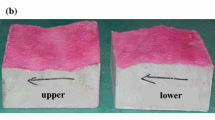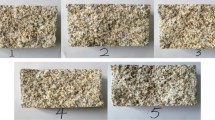Abstract
The scale effect is one of the important factors affecting the shear behavior of rock joints. However, the nature of the scale dependency of rock joints is still unknown. In this study, to evaluate the effect of scale on the mechanical behavior of the joint, we selected three natural surface joints with different geometries. The sizes of these surfaces were greater than 2500 cm2. The replica joints were prepared from these three surfaces with dimensions of 50 × 50 mm2, 100 × 100 mm2, and 200 × 200 mm2. Three types of materials were used with uniaxial strengths of 12.5, 26, and 35.2 MPa. In total, 90 direct shear tests were carried out on joint samples. Finally, using the results of direct shear tests on joint specimens, a criterion was proposed for estimating the shear strength of natural joints which considered the scale effect. Compared to the previous similar criteria, in the present criterion, to quantify the roughness of the surfaces, the joint surfaces were considered three-dimensional and several roughness parameters (instead of one parameter) were used to capture both first- and second-order roughness of surfaces. The scale effect was also considered the changes in the joint dimensions (in some previous similar criteria, changes in scanning resolution of the surfaces have been considered the scale effect). Furthermore, since the surfaces of artificial joints were copied from the natural joint surfaces (instead of tensile joint surfaces), it can be expected the results of the present criterion would have a better estimate of the shear strength of natural joints.








Similar content being viewed by others
References
American Standards Association (1955) American standard surface texture: surface roughness, waviness and lay. American Society of Mechanical Engineers
Armand, G. (2000) Contribution à la caractérisation en laboratoire et à la modélisation constitutive du comportement mécanique des joints rocheux (Doctoral dissertation, Université Joseph Fourier (Grenoble))
Azinfar MJ, Ghazvinian AH, Nejati HR (2016) Assessment of scale effect on 3D roughness parameters of fracture surfaces. Eur J Environ Civ Eng 23(1):1–28
Bahaaddini M, Hagan PC, Mitra R, Hebblewhite BK (2014) Scale effect on the shear behaviour of rock joints based on a numerical study. Eng Geol 181:212–223
Bandis, S. (1980) Experimental studies of scale effects on shear strength, and deformation of rock joints (Doctoral dissertation, University of Leeds)
Bandis S, Lumsden AC, Barton NR (1981) Experimental studies of scale effects on the shear behaviour of rock joints. Int J Rock Mech Min Sci Geomech Abstr 18(1):1–21 Pergamon
Barton N (1978) Suggested methods for the quantitative description of discontinuities in rock masses. ISRM, International Journal of Rock Mechanics and Mining Sciences & Geomechanics Abstracts 15(6):319–368
Barton N, Choubey V (1977) The shear strength of rock joints in theory and practice. Rock Mech 10(1-2):1–54
Belem T, Homand F, Souley M (2002) New shear strength criteria for rock joints taking into account anisotropy of surface morphology. In 5. North American Rock Mechanics Symposium & 17. Tunneling Association of Canada Conference 45-52
Buzzi O, Casagrande D (2018) A step towards the end of the scale effect conundrum when predicting the shear strength of large in situ discontinuities. Int J Rock Mech Min Sci 105:210–219
Castelli M, Re F, Scavia C, Zaninetti A (2001) Experimental evaluation of scale effects on the mechanical behavior of rock joints. Paper presented at the Proceedings of International Eurock Symposium. Espoo, Finland
Cottrell B (2009) Updates to the GG-shear strength criterion. M. Eng., University of Toronto at Toronto
El-Soudani SM (1978) Profilometric analysis of fractures. Metallography 11(3):247–336
Fardin N (2008) Influence of structural non-stationarity of surface roughness on morphological characterization and mechanical deformation of rock joints. Rock Mech Rock Eng 41(2):267–297
Fardin N, Stephansson O, Jing L (2001) The scale dependence of rock joint surface roughness. Int J Rock Mech Min Sci 38(5):659–669
Fardin N, Feng Q, Stephansson O (2004) Application of a new in situ 3D laser scanner to study the scale effect on the rock joint surface roughness. Int J Rock Mech Min Sci 2(41):329–335
Fishman YA (1990) Failure mechanism and shear strength of joint wall asperities. Rock joints:627–631
Flamand R (2000) Validation d'un modèle de comportement mécanique pour les fractures rocheuses en cisaillement. Université du Qu
Ghazvinian AH, Azinfar MJ, Vaneghi RG (2012) Importance of tensile strength on the shear behavior of discontinuities. Rock Mech Rock Eng 45(3):349–359
Giani GP, Ferrero AM, Passarello, G., & Reinaudo, L. (1992). Scale effect evaluation on natural discontinuity shear strength. In Proceedings of the conference on fractured and jointed rock masses, Lake Tahoe, CA 3-5
Giwelli AA, Sakaguchi K, Gumati A, Matsuki K (2014) Shear behaviour of fractured rock as a function of size and shear displacement. Geomechanics and Geoengineering 9(4):253–264
Grasselli G (2001) Shear strength of rock joints based on quantified surface description (No. THESIS). EPFL
Grasselli G, Egger P (2003) Constitutive law for the shear strength of rock joints based on three-dimensional surface parameters. Int J Rock Mech Min Sci 40(1):25–40
Hencher SR, Toy JP, Lumsden AC (1993) Scale-dependent shear strength of rock joints. Scale effects in rock masses 93:233–240
Huang TH, Chang CS, Chao CY (2002) Experimental and mathematical modeling for fracture of rock joint with regular asperities. Eng Fract Mech 69(17):1977–1996
ISRM (1978) International Society for Rock Mechanics commission on standardization of laboratory and field tests: suggested methods for the quantitative description of discontinuities in rock masses. Int J Rock Mech Min Sci Geomech Abstr 15(6):319–368
Johansson F (2016) Influence of scale and matedness on the peak shear strength of fresh, unweathered rock joints. Int J Rock Mech Min Sci 82:36–47
Krsmanovic D, Popovic M (1966) Large scale field tests of the shear strength of limestone. In the 1st ISRM Congress. International Society for Rock Mechanics and Rock Engineering
Kutter HK, Otto F (1990) Influence of parallel and cross joints on shear behaviour of rock discontinuities. Proc. Rock Joints. Loen, Norway, 243-50
Leal-Gomes MJA (2003) Some new essential questions about scale effects on the mechanics of rock mass joints. In the 10th ISRM Congress. International Society for Rock Mechanics and Rock Engineering
Lee HS, Ahn KW (2004) A prototype of digital photogrammetric algorithm for estimating roughness of rock surface. Geosci J 8(3):333–341
Leichnitz W, Natau O (1979) The influence of peak shear strength determination on the analytical rock slope stability. In the 4th ISRM Congress. International Society for Rock Mechanics and Rock Engineering
Locher HG, Rieder UG (1970) Shear tests on layered Jurassic limestone. International Society of Rock Mechanics, Proceedings 1:1–19
Maerz NH, Franklin JA (1990) Roughness scale effect and fractal dimension
Malinverno A (1990) A simple method to estimate the fractal dimension of a self-affine series. Geophys Res Lett 17(11):1953–1956
Muralha J, Pinto Da Cunha A (1990) About LNEC experience on scale effects in the mechanical behaviour of joints. PROCEEDINGS OF THE FIRST INTERNATIONAL WORKSHOP ON SCALE EFFECTS IN ROCK MASSES, LOEN, NORWAY, JUNE 7-8. Publication of: Balkema (AA)
Oh J, Cording EJ, Moon T (2015) A joint shear model incorporating small-scale and large-scale irregularities. Int J Rock Mech Min Sci 76:78–87
Ohnishi Y, Yoshinaka R (1995) Laboratory investigation of scale effect in mechanical behavior of rock joint. In The 2nd international conference on the mechanics of jointed and faulted rock–MJFR-2, Vienna, Austria 465-470
Park JW, Song JJ (2009) Numerical simulation of a direct shear test on a rock joint using a bonded-particle model. Int J Rock Mech Min Sci 46(8):1315–1328
Pratt HR (1974) Friction and deformation of jointed quartz diorite. In Proc. 3rd ISRM Congress, Denver 306-310
Swan G, Zongqi S (1985) Prediction of shear behaviour of joints using profiles. Rock Mech Rock Eng 18(3):183–212
Tang ZC, Jiao YY, Wong LNY, Wang XC (2016) Choosing appropriate parameters for developing empirical shear strength criterion of rock joint: review and new insights. Rock Mech Rock Eng 49:4479–4490
Tatone BS, Grasselli G (2009) A method to evaluate the three-dimensional roughness of fracture surfaces in brittle geomaterials. Rev Sci Instrum 80(12):125110
Tatone BS, Grasselli G (2013) An investigation of discontinuity roughness scale dependency using high-resolution surface measurements. Rock Mech Rock Eng 46(4):657–681
Tatone BSA, Grasselli G, Cottrell B (2010) Accounting for the influence of measurement resolution on discontinuity roughness estimates. In ISRM International Symposium-EUROCK 2010. International Society for Rock Mechanics and Rock Engineering
Ueng TS, Jou YJ, Peng IH (2010) Scale effect on shear strength of computer-aided-manufactured joints. J GeoEng 5(2):29–37
Yong R, Qin JB, Huang M, Du SG, Liu J, Hu GJ (2019) An innovative sampling method for determining the scale effect of rock joints. Rock Mech Rock Eng 52(3):935–946
Yoshinaka R, Yoshida J, Shimizu T, Arai H, Arisaka S (1991) Scale effect in shear strength and deformability of rock joints. In the 7th ISRM Congress. International Society for Rock Mechanics and Rock Engineering
Yoshinaka R, Yoshida J, Arai H, Arisaka S (1993) “Scale effects on shear strength and deformability of rock joints. Second International Workshop on Scale Effects in Rock Masses, Taylor & Francis, Lisbon, Portugal 143–149
Funding
This research has been done at the University of Sistan and Baluchestan and Tarbiat Modares University, and no funding has been received from any company.
Author information
Authors and Affiliations
Corresponding author
Ethics declarations
Conflict of interest
The authors declare no competing interests.
Additional information
Responsible Editor: Zeynal Abiddin Erguler
Appendix
Appendix
The variations of roughness parameter values for joint surface sizes of 25 to 400 cm2 have been depicted in Fig. 9.
Rights and permissions
About this article
Cite this article
Azinfar, M.J., Ghazvinian, A. & Fatemi, S.A. A new peak shear strength criterion of three-dimensional rock joints considering the scale effects. Arab J Geosci 14, 936 (2021). https://doi.org/10.1007/s12517-021-07319-5
Received:
Accepted:
Published:
DOI: https://doi.org/10.1007/s12517-021-07319-5





